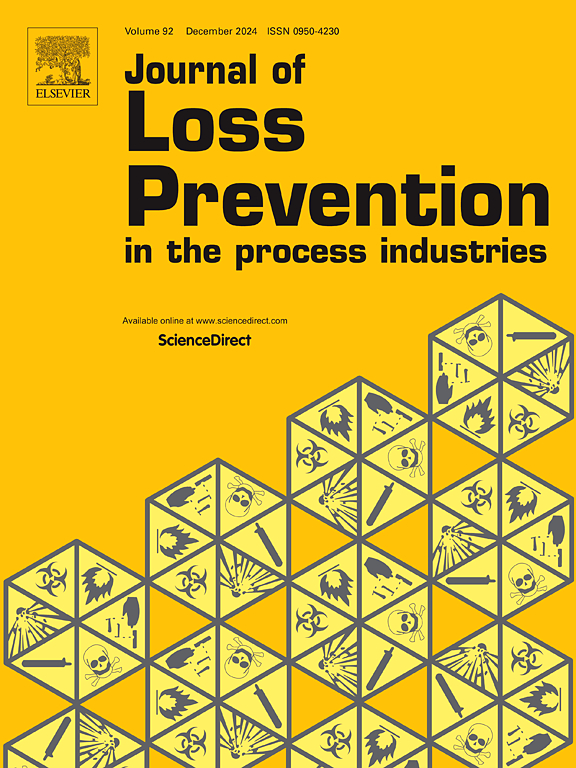A study on the mechanisms of non-adaptive psychological emotional contagion and evacuation behavior in chemical parks
IF 3.6
3区 工程技术
Q2 ENGINEERING, CHEMICAL
Journal of Loss Prevention in The Process Industries
Pub Date : 2025-04-22
DOI:10.1016/j.jlp.2025.105655
引用次数: 0
Abstract
In recent years, the ongoing expansion and advancement of chemical parks have led to a significant increase in the frequency of chemical accidents, which pose a substantial threat to both public safety and property. However, the majority of casualties are not caused directly by the accidents themselves, but rather by extreme behaviors triggered by non-adaptive psychological responses during the evacuation process. Consequently, this study examines the influence of maladaptive psychological emotional contagion on the emergency evacuation processes within chemical parks. Initially, the mechanisms underlying emotional contagion caused by maladaptive psychological responses during evacuation are analyzed. A system dynamics model of pedestrian emotional contagion is constructed using the SEIR (Susceptible-Exposed-Infectious-Recovered) framework, which quantitatively assesses the influence of various factors on the emotional contagion process while exploring the dynamic behavior of emotional contagion within a crowd. The study reveals that increased environmental familiarity with the results in a reduction in the intensity of emotional contagion; as the severity of the disaster spread, the pace of emotional contagion accelerates, and contagion between pedestrians intensifies; furthermore, as the intervention of emergency personnel increases, the number of Recovered significantly rises, though the growth rate eventually diminishes. Additionally, early intervention proves effective in mitigating emotional contagion; however, as the intensity of the intervention rises, its efficacy diminishes. By simulating a real chemical park evacuation scenario, the study demonstrates that moderate panic can enhance evacuation efficiency, while confirming the trend of environmental familiarity in real-world scenarios. This paper offers theoretical insights into the evolutionary mechanisms of maladaptive psychological emotional contagion, while providing guidance for the formulation of effective evacuation strategies.
化工园区非适应性心理情绪感染与疏散行为机制研究
近年来,随着化工园区的不断扩建和推进,化工事故的发生频率显著增加,对公共安全和财产构成了重大威胁。然而,绝大多数伤亡并不是由事故本身直接造成的,而是由于疏散过程中非适应性心理反应引发的极端行为。因此,本研究探讨了适应不良心理情绪传染对化工园区内应急疏散过程的影响。首先,分析了疏散过程中不良心理反应引起情绪感染的机制。采用SEIR(易感-暴露-感染-恢复)框架构建行人情绪感染的系统动力学模型,定量评估各种因素对情绪感染过程的影响,探索人群中情绪感染的动态行为。研究表明,增加对环境的熟悉程度会降低情绪感染的强度;随着灾害严重程度的蔓延,情绪传染的速度加快,行人之间的传染加剧;此外,随着应急人员干预的增加,恢复的数量显著增加,尽管增长率最终会下降。此外,早期干预被证明对减轻情绪传染有效;然而,随着干预力度的加大,其效果会减弱。通过模拟真实化工园区疏散场景,研究表明适度恐慌可以提高疏散效率,同时也证实了真实场景中环境熟悉度的趋势。本文为研究适应不良心理情绪感染的进化机制提供了理论见解,同时也为制定有效的疏散策略提供了指导。
本文章由计算机程序翻译,如有差异,请以英文原文为准。
求助全文
约1分钟内获得全文
求助全文
来源期刊
CiteScore
7.20
自引率
14.30%
发文量
226
审稿时长
52 days
期刊介绍:
The broad scope of the journal is process safety. Process safety is defined as the prevention and mitigation of process-related injuries and damage arising from process incidents involving fire, explosion and toxic release. Such undesired events occur in the process industries during the use, storage, manufacture, handling, and transportation of highly hazardous chemicals.

 求助内容:
求助内容: 应助结果提醒方式:
应助结果提醒方式:


